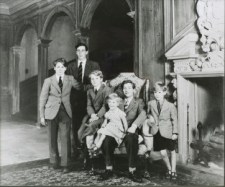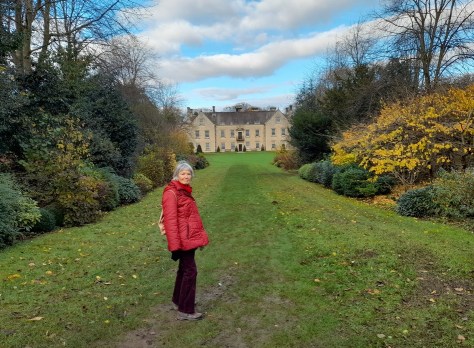There has been a manor house beside the River Rye in the small village of Nunnington (lying within the Howardian Hills National Landscape of North Yorkshire) since the 13th century.
Built from a light colored coral rag Jurassic limestone, the Nunnington Hall estate occupies around 5 acres (2 ha) and is surrounded by a walled garden. The house has changed in character over the centuries, as each resident (owner or tenant) stamped their mark on its architecture and layout. It has been owned and managed by the National Trust since 1952, although it remained a family home until 1978.
In Tudor times there were distant royal connections, and during the 17th century English Civil Wars, Parliamentarian troops were garrisoned in the Hall.
 A wealthy cloth merchant, Ranald Graham (right, created Viscount Preston in the Peerage of Scotland in 1681, died 1689) bought the Nunnington estate in 1655, and it remained in the family until the mid-18th century when the direct Graham line became extinct. Sublet and allowed to deteriorate, it was offered up for sale in 1839 in a semi-derelict state, and bought by William Rutson (1791-1867) whose family had made their fortune through colonial trade and slavery.
A wealthy cloth merchant, Ranald Graham (right, created Viscount Preston in the Peerage of Scotland in 1681, died 1689) bought the Nunnington estate in 1655, and it remained in the family until the mid-18th century when the direct Graham line became extinct. Sublet and allowed to deteriorate, it was offered up for sale in 1839 in a semi-derelict state, and bought by William Rutson (1791-1867) whose family had made their fortune through colonial trade and slavery.

The five children of Susan and Peter Clive and their cousin Michael in the Oak Hall at Nunnington Hall.
Nunnington Hall was inherited by Margaret Fife (née Rutson, the great-niece of William Rutson) in 1920, and she set about the renovation of the Hall with her husband, Colonel Ronald D’Arcy Fife, funding the project from the sale of another Rutson property, Newby Wiske near Northallerton. One of their adopted daughters, Susan Clive, raised her family at Nunnington Hall, until moving to a house in the village.
I first visited Nunnington Hall in the summer of 1968, but recall very little of that visit, since only a few rooms were open to the public, and then only twice a week. It was only after the family vacated the Hall that the National Trust opened more of the house to the public, and more frequently.
In 2013, Steph and I stopped off on our way back south after visiting family in Newcastle.
Unlike Worcestershire where we lived until 2020, there are just a few National Trust properties near our home (since 2020) here in the northeast. And not all open for the Christmas season. I wrote briefly about our various Christmas visits after last year’s to Ormesby Hall near Middlesbrough.
So, on Friday last, we made the 162 mile round trip from North Tyneside to enjoy Nunnington Hall decorated in its Christmas finery. Being the first day of the Hall’s Christmas season (only each Friday to Sunday until just before Christmas), it was a delight to see many of the rooms brightly lit with Christmas trees and candles.
Let me take you on a brief tour of the house in 2013 and last Friday, highlighting some of the features that particularly caught my attention. A photo album of all the photos taken during both visits can be viewed here.
The entrance was suitably decorated for the Hall’s Christmas season, and we headed straight for the tearoom (with waitress service, unusual for National Trust tearooms) for a welcome cup of coffee before beginning the tour.

A kitchen or a Great Hall in earlier centuries, by 1921 the Stone Hall had become the entrance hall on the west facade of the building. One wall is hung with shooting trophies (mainly antelope of one species or another), with the skins of big cats on another. A huge fireplace (which was lit on our recent visit) dominates a third wall. And for Christmas, there was a tall (maybe 15 foot) tree, a Fashionable Victorian theme, with one of the volunteers (dressed as a butler) offering a small sherry or cranberry juice to each new visitor.
The Smoking Room, a few steps up from the Stone Hall, was Lord Preston’s bedchamber in the 17th century, but was adopted by Colonel Fife. The walls were painted Georgian green by Margaret Fife, and its theme was an indulgent Georgian Christmas. On our 2013 visit, this room was set up as a small dining room. And beyond the main room, in a small withdrawing room, the walls are covered in 18th century prints, and the ceiling decorated with original coats of arms.
From the Smoking Room, you step into the large Oak Hall with its stone floor, stone fireplace, and elegant, low-rise staircase leading to the first floor. This was an open courtyard in Tudor times, but was enclosed by Lord Preston in the late 17th century. There was a Tudor feast theme last Friday.
There are several paintings of William Rutson and his horses.

L: William Rutson’s groom and horses; R: William Rutson on a grey hunter
Hanging on the walls above the staircase are three tapestries, 300 years old, and another one in the Sitting Room.
During Margaret Fife’s time, the Sitting Room was the main family room, with a balcony overlooking the walled garden, with its terraces and orchard. Peacocks also strutting around the grounds. The Christmas theme was 1980s Party Time.
One feature which caught my attention in 2013 (and still prominently on display) was the superb set of porcelain figurines—Chelsea I presume—on the mantelpiece. How I would like to own a set like that, but my pockets aren’t deep enough!
In Margaret Fife’s bedroom and dressing room on the first floor, there is a charming (but controversial) portrait of her as a young girl, hanging above the fireplace.

Colonel Fife had his own bedroom, and particular feature that you can’t miss is the Chinese-style wallpaper, decorated with birds, flowers, and fruits.
A child’s bedroom, decorated with a tree and toys completed the bedrooms that were open. Wood-paneled, I seem to remember from our 2013 visit that there were carvings or graffiti in the wood made by Parliamentarian soldiers in the 17th century.
Schoolchildren from the nearby Slingsby Community Primary School had created the snowman exhibit in another bedroom.
The Nursery had a 1940s Rationing theme. The walls were covered with another impressive wallpaper, and a delightful doll’s house stood in one corner.
The attic floor under the eaves houses a couple of exhibitions. One of these is the permanent home of a collection of miniature rooms, donated to the National Trust by Londoner, Mrs Carlisle (known as ‘Kitty’). The models are truly exquisite in the amount of detail, even handwriting on miniature letters. The other exhibition, Fields, Folds, and Farming Life on display last week was a collection of photos and videos of farming life in Yorkshire by photographer Valerie Mather.
After a short (and rather muddy) walk around the garden, our visit to Nunnington Hall came to an end, and we headed back home.

But with just one other feature in the landscape to find: the Kilburn White Horse (map)The origin of the horse is disputed, but it appeared in November 1857, cut into the hillside above the village of Kilburn. Some credit the local schoolmaster and his pupils. The top soil was scraped away, and the horse covered in limestone chippings. It has needed regular maintenance over the years.

The Kilburn White Horse can be clearly seen from a distance, particularly from the A19 between Thirsk and York.

We made our way down the escarpment to the car park just below the horse, but from there you can only see the horse’s legs and part of its body.

I can’t finish this post without mentioning the spectacular climb into the Howardian Hills.
We had traveled south from North Tyneside on the A19 as far as Thirsk, where we took the A170 towards Scarborough. Just under six miles east of Thirsk, the A170 ascends the notorious Sutton Bank, with its 25% incline and hairpin bends. It’s such a challenge for some vehicles that caravans are banned from this stretch of road and have to find an alternative route on to the moors. Even HGVs struggle up the Bank.
Here’s some footage I made of the ascent and descent (almost 5 minutes, and available in HD).










































































